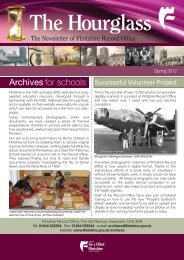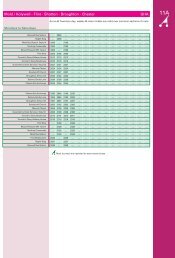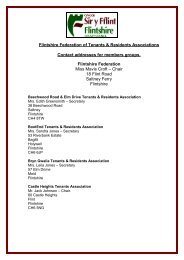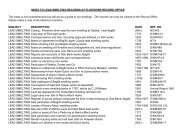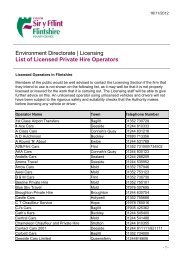Caerwys Eng.indd - Flintshire County Council
Caerwys Eng.indd - Flintshire County Council
Caerwys Eng.indd - Flintshire County Council
Create successful ePaper yourself
Turn your PDF publications into a flip-book with our unique Google optimized e-Paper software.
Daily life<br />
In the early 20th century, few people travelled far from their homes<br />
and the wide range of shops in the town provided all daily needs.<br />
In the 1950s, there<br />
“From time to time, when we boys were walking to were three butchers,<br />
school, we heard pigs squealing and knew the butcher three grocers, two<br />
was slaughtering that day. After school, we would go drapers, two bakehouses,<br />
straight to the butcher’s in North Street and ask for a an ironmongers, a<br />
pig’s bladder. Then we lads would blow it up, tie a knot blacksmiths and several<br />
in the neck and have a grand time kicking it about The smaller shops, mainly<br />
Cross until it burst.”<br />
selling sweets and<br />
Tom Anwyl (recalling the late 1920s, early 1930s) newspapers. Many<br />
locals recall the smell of<br />
ground coffee and the boxes of broken biscuits in the grocers and the<br />
tantalising smells from the chip shop at Liverpool House.<br />
<strong>Caerwys</strong> also boasted two<br />
banks and a Post Office. The<br />
first Post Office was originally<br />
on the High Street. It later<br />
moved to The Square but<br />
was gutted by fire in 1963<br />
and then reopened in Central<br />
Stores on Water Street (where<br />
it remains today, now part<br />
of Morgan’s Pori Gwych).<br />
"The shop at Manchester House, next<br />
to the Town Hall, sold newspapers and<br />
books. People would buy a book, read it<br />
and then bring it back to be re-sold."<br />
Dilys Jones<br />
“Oswald Stores, now Will’s News,<br />
sold groceries on one side and<br />
was a drapers on the other side.<br />
You could order anything from a<br />
corset to a suit!”<br />
Berwyn Roberts<br />
The fire triggered Jack Featherstone, then<br />
landlord of the Royal Oak, to organise<br />
a volunteer fire service to provide early<br />
assistance whilst the fire engine was<br />
travelling from Holywell.<br />
Only four shops now remain in the town but several of the former shops<br />
are recognisable by their large front windows.<br />
In 1828 the town had eight inns, to meet the needs not just of locals<br />
but the numerous travellers, drovers and fair goers. Nowadays only three<br />
pubs remain but all provide a welcome to both locals and visitors.<br />
The Piccadilly Inn is situated at the northern edge of the town, and<br />
may date from 1662. Many years ago the inn was owned by Lord<br />
Mostyn, who was extremely fond of horseracing. One of his horses,<br />
named Piccadilly, won a race on the old Holywell Racecourse near<br />
Babell and, as a reward, Lord Mostyn gave the inn to his jockey who<br />
named the pub after the victorious horse. (Tel: 01352 720284)<br />
The Royal Oak on Water Street in the heart of <strong>Caerwys</strong>, dates back<br />
to the 16th century. (Tel: 01352 720269)<br />
The Pwll Gwyn on the Mold-Denbigh road at Afonwen may have<br />
originally been a dower house for Maesmynan Hall. It was later<br />
a coaching inn and a stopping point for drovers.<br />
(Tel: 01352 720227)



